Of Note
- A Valediction: Forbidding Mourning
- The Thomas and Evon Cooper International Competition
- $1.7 Million Gift from Helen Hodam Funds
- Author, Author
- Great Performances—In Oberlin, on the Road, and on CD
A Valediction: Forbidding Mourning
As this issue of Oberlin Conservatory was going to press, Professor of African American Studies Wendell Logan, the architect of Oberlin’s Jazz Studies Department, passed away following a brief illness—just six weeks after the spectacular weekend celebrating jazz at Oberlin and its new home in the Bertram and Judith Kohl Building. This article was originally intended to offer you a brief glimpse of the festivities, with more comprehensive coverage to follow in a future issue. But what to say now? How to capture that lightning in a bottle while this loss is so fresh? When words fail, turn to the power of the image—hence the montage on the inside front cover of this magazine.
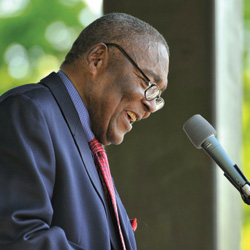
Professor Wendell Logan
(photo by Kevin G. Reeves)
There are many powerful images from that weekend: Professor Logan welcoming back returning graduates of the program; receiving a standing ovation when it was announced at the dedication that the lobby of the Kohl Building would be named for him; or on the Finney stage, leading the Oberlin Jazz Ensemble, students from the conservatory’s classical halls, members of the jazz studies faculty, and the legendary Stevie Wonder in a concert of incredible passion and artistry. The joy and enthusiasm with which Professor Logan experienced all of this was a sight to see. Wendell Logan was jazz at Oberlin.
But of all these extraordinary moments, just one captures the power and meaning of those heady days for me. It didn’t occur during the festivities, but the Monday after, and there’s no photo of it; it resides only in my memory. A reporter for the Cleveland Plain Dealer came to campus to interview Professor Logan for a profile he was writing. The conversation took place in what would have been Professor Logan’s office. Bare walls and empty bookshelves—nothing more than a piano, a piano bench, and a chair. The image is compelling because of the quiet and emptiness surrounding it—a stark contrast to the gaiety of the previous two days—and because his time in that space was so foreshortened, although we could not have known it then. He was asked about his life in music, his career at Oberlin, and what the new Kohl Building meant to him. He was, as the article reported, “basking only in the glory of his office in the newly built … building.” He was humble: “I’m just a facilitator. You never create anything without help … none of us is more important than the janitor.”
He talked about the ones truly “responsible” for the success of jazz at Oberlin—his colleagues and students. “They’re the ones who trust me and let me be part of their lives. I’m just the vehicle.”
But saxophone performance major Johnny Cochran Jr. ’12 put the reporter wise. “He’s the foundation,” he said. “He’s like my other father, when my real father’s not here, and his music is like nothing else I’ve ever heard.”
Johnny’s “other father” is the one who’s not here now. But Johnny surely knows, as all of us do, that Professor Logan will really be here forever.
Marci Janas ’91 has served as director of conservatory communications and editor of this magazine since 2002. She is leaving Oberlin in September to follow her new husband to Richmond, Virginia, where she plans to work and write and continue contributing to Oberlin Conservatory.
The Thomas and Evon Cooper International Competition
The conservatory and the Cleveland Orchestra have embarked upon a new partnership that will enhance educational opportunities for young musicians while building on the historic relationship between the two institutions.
In summer 2010, Oberlin joins with the Cleveland Orchestra to offer an important new international competition for young musicians that features more than $20,000 in total prize money; a concerto round performance with the orchestra; full four-year scholarships to Oberlin for the top three finalists (pending admission) that are valued at more than $100,000 each; and, for the first-prize winner, concert engagements with orchestras in Beijing and Shanghai.
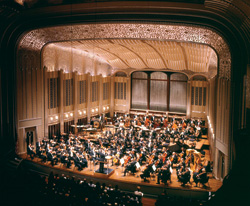
(Photo by Roger Mastroianni)
The Thomas and Evon Cooper International Competition, sponsored by Thomas Cooper ’78 and his wife, Evon, debuts this year for pianists, and alternates annually thereafter with a competition for violinists. Open to musicians between the ages of 13 and 18, the competition culminates in a final concerto round, open to the public, at Severance Hall, where the top three competitors will perform with the Cleveland Orchestra, conducted by Jahja Ling. The first-prize winner will take home $10,000, one of the largest prizes offered by an international youth competition.
“For an aspiring musician, there is no greater thrill than performing with one of the world’s great orchestras,” says Dean of the Conservatory David H. Stull. “This gift from the Cooper family pro-vides an extraordinary and unparalleled opportunity for young pianists and violinists from around the world. We are deeply honored that Tom and Evon have chosen the conservatory and the Cleveland Orchestra as hosts for this remarkable competition.”
“Evon and I are thrilled to be part of this exciting endeavor,” says Tom Cooper. “We believe it is important to encourage and support young artists in pursuing their musical aspirations, and we hope that the Cooper Competition serves to identify and showcase top youth talent from around the world for many years to come.” Cooper, a member of Oberlin’s Board of Trustees, is a partner in the investment firm of Grantham, Mayo, Van Otterloo & Company in Boston; Evon is a pianist. They live in the Boston area.
“This new initiative of the Cleveland Orchestra and the Oberlin Conservatory of Music invigorates our historic relationship,” says Gary Hanson, executive director of the Cleveland Orchestra. “We are pleased that our orchestra and the Severance Hall stage will be integral to the Cooper Competition, and we look forward to welcoming its gifted young musicians to Cleveland.”
Professor of Piano and Director of Keyboard Studies Robert Shannon, the director of the Cooper Competition in piano, says that the competition seeks to recognize and encourage outstanding young musicians, and its wealth of prizes will establish it as one of the foremost competitions of its kind: “This partnership allows us to create a unique event: a high-level piano competition in a festival atmosphere with opportunities for enrichment and education for everyone.”
The Cooper Competition evolved from the Oberlin International Piano Competition and Festival, which was held at the conservatory each summer for 14 years, from 1995 through 2008, and directed by Shannon. Professor of Violin Gregory Fulkerson will direct the 2011 violin competition. More information can be found at www.oberlin.edu/cooper.
$1.7 Million Gift from Helen Hodam
Funds Scholarship in Voice
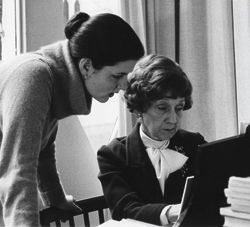
Helen Hodam, at right, with a student
Throughout her long life, Helen Hodam gave generously of her time and talents, helping dozens of students to build careers in classical singing. Now, another generous gift will continue her life’s work, allowing generations of talented young singers to study at Oberlin.
A $1.7 million gift from the legendary voice teacher’s estate has established and will endow the Helen Hodam Merit Scholarship in Voice at the conservatory. A professor of singing at Oberlin for more than two decades, “Miss Hodam,” as she was universally addressed, was one of the most distinguished voice teachers in the United States. She died on May 21, 2008, in Cambridge, Massachusetts, at the age of 93.
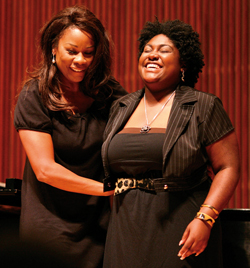
Denyce Graves teaches a master class
(photo by Roger Mastroianni)
Miss Hodam’s students performed with many of the world’s major opera companies, from the Metropolitan Opera to La Scala. Notable singers whom she taught at Oberlin include Lisa Saffer ’82, Ann Panagulias ’84, and Denyce Graves ’85, hon. ’98.
In celebration of Miss Hodam’s life and legacy, Graves returned to the conservatory in October 2009 to perform, with pianist Warren Jones, on Oberlin’s Artist Recital Series. She also conducted a master class for Oberlin voice students. At a reception following the concert, she spoke about Miss Hodam’s profound influence on her life and career.
“She was a woman who really dedicated her life to her students,” Graves said. “I find myself on the path that I’m on because of her … I’m just so grateful for what she’s given to my life.”
“The talent and dedication that Helen Hodam brought to teaching young singers was nothing short of extraordinary,” says Dean of the Conservatory David H. Stull. “This generous gift from Miss Hodam will ensure that talented students are financially supported as they pursue rigorous training in vocal performance at the Oberlin Conservatory.”
A large portion of Miss Hodam’s career was spent at Oberlin, where she taught from 1963 to 1984. Her passion for teaching compelled her to continue working after retiring from Oberlin, as a professor at Boston’s New England Conservatory, until illness forced her to retire in 2003.
In accordance with Miss Hodam’s wishes, the scholarship fund will enable extraordinary undergraduate students to attend the conservatory. The Class of 2014 will include the first students to benefit from Miss Hodam’s scholarship gift.
Author, Author
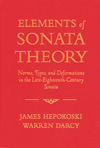
For the second time in his scholarly career, Professor of Music Theory Warren Darcy ’68 has won the Wallace Berry Award. The honor was conferred upon Darcy and his coauthor, James Hepokoski, for Elements of Sonata Theory: Norms, Types, and Deformations in the Late-Eighteenth-Century Sonata (Oxford, 2006) at the 2008 annual meeting of the Society for Music Theory (SMT) held in Nashville, Tennessee.
Calling the volume “rigorously researched” and “nuanced,” the award citation praises the authors for “illuminating ways of explaining problematic situations,” and ultimately inspiring “new discoveries about familiar works,” noting that their “new approach to understanding Classical-era movements in sonata form and the larger works to which they belong … convincingly redefine[s] sonata form.”
Darcy previously won the Wallace Berry Award in 1995 for his book Wagner’s ‘Das Rheingold’, published by Oxford University Press in 1993. He is the only scholar in the history of the award to have won it twice. “This book was a rather unique collaboration between a music theorist and a musicologist, who typically have quite different concerns and methodologies,” says Darcy. Hepokoski, a former professor of musicology at Oberlin, was a member of the faculty from 1978 to 1988; he is currently professor of music at Yale University.

In April 2009, MENC: The National Association for Music Education and Rowman & Littlefield Education published Musical Experience in Our Lives: Things We Learn and Meanings We Make, edited by Professor of Music Education Jody Kerchner and Carlos R. Abril, a member of the music education faculty at Northwestern University. The book provides a wide-angle view of the multifaceted dimension of the musical experience, meaning, and learning, throughout the human lifespan.
Twenty leading experts contributed to the book’s chapters, employing various qualitative research methodologies to describe how people engage in musical experiences as they listen to, move to, sing, compose, and play music.
“Music plays so many roles in our lives, from those who create music to those who listen to music on iPods,” says Kerchner. “Those who develop music pedagogy will learn from these collected experiences and trends, and can help shape the future of music education.”
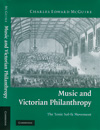
In 2009 Cambridge University Press published Music and Victorian Philanthropy: The Tonic Sol-fa Movement, by Associate Professor of Musicology Charles McGuire ’92. The book provides a fresh approach to the social history of the Victorian era by examining the history and development of the tonic sol-fa sight-singing system and its impact on British society. Instead of focusing on the popular classical music canon, McGuire combines musicology, social history, and theology to investigate the perceived power of music within the Victorian era. Through case studies on temperance, missionaries, and women’s suffrage, the book traces how John Curwen and his son transformed Sarah Glover’s sight-singing notation from a strictly local phenomenon into an internationally used system, building an infrastructure that promoted its use within Great Britain and beyond.
Great Performances—In Oberlin, on the Road, and on CD
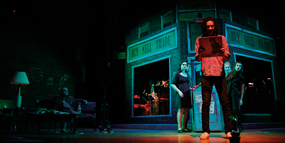
Leave Me Alone!: The world premiere of a jazz opera by the late graphic novelist Harvey Pekar and saxophonist Dan Plonsey (Finney Chapel, January 2009) was streamed online to an international audience, and garnered considerable media attention. Clockwise from front: Christopher Rice ’10, Kate Rosen ’11, Gerard Michael D’Emilio ’11, Patty Stubel ’09, and Joanna Lemle ’10 hunt for records; librettist Pekar looks on. (photo by John Seyfried)
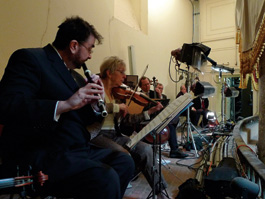
Performing on the balcony of Statuary Hall in what used to be the Old Senate Chamber, overlooking the Washington glitterati attending the traditional bipartisan inaugural luncheon on the occasion of Barack Obama’s inauguration as the 44th president of the United States in January 2009: Professor of Violin Marilyn McDonald (second from left) and Professor of Recorder and Baroque Flute Michael Lynn (left). (photo Courtesy Of Michael Lynn)
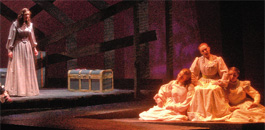
Les Arts Florissants: The historically informed staging of Charpentier’s baroque opera Les Arts Florissants debuted in Oberlin during Commencement and Reunion Weekend 2009 and was presented that June at the Boston Early Music Festival, earning special mention in several significant reviews. New York Times critic Allan Kozinn pronounced it “elegantly staged, finely polished”; the Wall Street Journal agreed, calling it “enchanting.” A project of the Historical Performance Division, Les Arts Florissants was directed by Associate Professor of Harpsichord Webb Wiggins. Left to right: Nathan Medley ’09 as La Peinture, Sara Casey ’10 as La Paix, Johanna Bronk ’09 as L’Architecture, Charlotte Beers ’11 as La Poesie, Molly Netter ’10 as La Musique, Dominic Johnson ’11 as La Discorde, and in the pit, Steuart Pincombe ’10 (viol), Tatiana Chulochnikova ’10 (violin), Fiona Hughes ’10 (violin), Jacob Farnsworth ’11 (flute), and Colin Brown ’09 (flute).
(photo by John Seyfried)
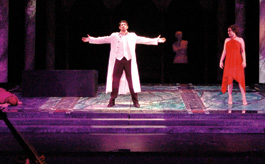
Oberlin Opera Theater—L’incoronazione di Poppea: Joseph Turro ’09 as Nero and Lillie Chilen ’08 as Poppea, March 2008
(photo by Roger Mastroianni)
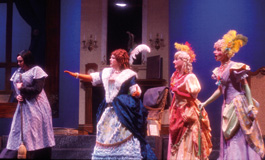
Oberlin Opera Theater—Cendrillon: Plain Dealer critic Donald Rosenberg wrote: the production “exult[ed] in the wit, lyricism and ethereal allure” of Massenet’s score and Cain’s libretto. Left to right: Alyssa Cox ’09 as Cendrillon, Emily Cruz-Nowell ’10 as Madame de la Haltière, Alexandra Roth ’09 as Dorothée, and Elizabeth Zharoff ’09 as Noémie, November 2008
(photo by John Seyfried)
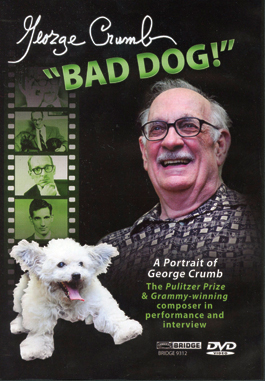
Professor of Piano Robert Shannon has long been an interpreter of George Crumb, and considers the avant-garde composer a friend as well as an inspiration. Shannon performs in a 2009 film celebrating the composer’s life. Bad Dog!, available on DVD, was released by Bridge Records, the label most closely associated with Crumb’s oeuvre. Bridge producer David Starobin directed the film. Soprano Tony Arnold ’90 also appears.
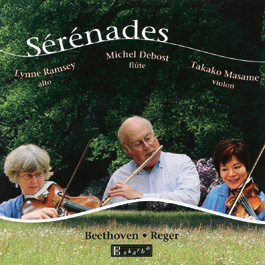
The conservatory’s Warner Concert Hall has long been a favorite venue for Oberlin recording artists. In June 2008, Professor of Flute Michel Debost convened a session with former viola faculty member Lynne Ramsey and violinist Takako Masame, both members of the Cleveland Orchestra, to produce Sérénades, released in 2009 by Skarbo. The recording juxtaposes Beethoven’s op. 25 Sérénade with two by Max Reger, Sérénades op. 77 and op. 141. Director of Audio Services Paul Eachus produced the CD and engineered the sound.

J.F. Oberlin University in Tokyo, known as Oberlin College’s “Cousin to the East,” was the site of performances by members of the conservatory faculty in January 2009. Professor of Bassoon George Sakakeeny, Associate Professor of Singing Lorraine Manz, Associate Professor of Viola Karen Ritscher, and Professor of Instrumental Accompanying James Howsmon presented recitals and master classes to enthusiastic students. (photos by Peter Mattersdorf)
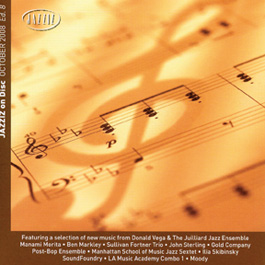
Pianist Sullivan Fortner ’08 hit the big time in October 2008 when his elegant up-tempo ballad “I Can’t Believe This Happened” was featured on JAZZIZ on Disc, the companion CD to JAZZIZ magazine. Fortner performs on the recording with Christopher Mees ’09 on bass and Alex Ritz ’08 on drums. Garroch Neil ’08 and Noah Weiss ’09 engineered the track, which was produced and recorded at the conservatory in May 2008.
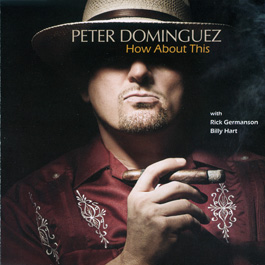
Professor of Jazz Studies and Double Bass Peter Dominguez’ self-produced CD, How About This, features his Oberlin colleague Billy Hart, assistant professor of jazz percussion, on drums; pianist Rick Germanson rounds out the trio. Dominguez wrote the title song and did all of the arrangements for the other tunes on the CD, which include Quincy Jones’ “Stockholm Sweetnin’” and Thelonious Monk’s “Ask Me Now.” The album was recorded at the Leon Lee Dorsey Recording Studio in Manhattan in 2007 and released in 2009. Visit www.PeterDominguezMusic.com for more information.
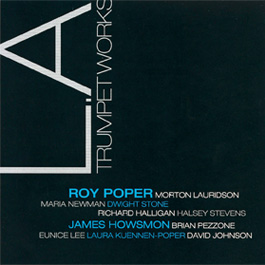
In 2009, Associate Professor of Trumpet Roy Poper stepped out into the spotlight with his debut solo album, L.A. Trumpet Works, featuring works by Los Angeles based-composers. He had a little help from some of his friends; Professor of Instrumental Accompanying James Howsmon is among those appearing with him on the disc.
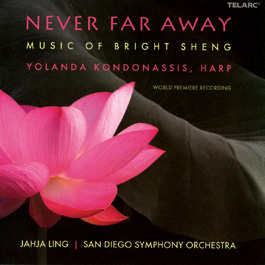
Assistant Professor of Harp Yolanda Kondonassis collaborated with Chinese composer Bright Sheng for the world-premiere recording of his concerto for harp and orchestra. Never Far Away, the name of the concerto as well as the disc, was released in 2009 by Telarc, and features Jahja Ling conducting the San Diego Symphony.
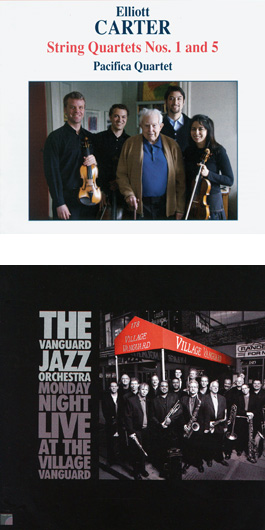
51st Annual Grammy Awards: In 2009, the Pacifica String Quartet, which includes Oberlin alumni Sibbi Bernhardsson ’95 and Simin Ganatra ’95, took home its first Grammy Award, for Best Chamber Music Performance, for their Naxos recording of Elliott Carter’s String Quartets Nos. 1 and 5. Jason Jackson ’93, trombonist with the Vanguard Jazz Orchestra for more than a decade, shared a Grammy with the VJO, for Best Large Jazz Ensemble, for Monday Night Live at the Village Vanguard, a Planet Arts release. This was Jackson’s second Grammy with the group, with whom he performs every Monday night. Live. At the Village Vanguard.
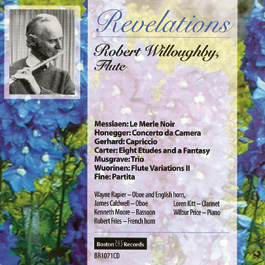
Emeritus Professor of Flute Robert Willoughby’s Revelations (Boston Records, 2008), features live performances that were recorded in Warner Concert Hall in the 1960s and 1970s. Willoughby and former Oberlin faculty members James Caldwell and Wayne Rapier (oboe), Loren Kitt (clarinet), Kenneth Moore (bassoon), Robert Fries (horn), and Wilbur Price (piano), play works by Messiaen, Honegger, Elliott Carter, and Irving Fine.
